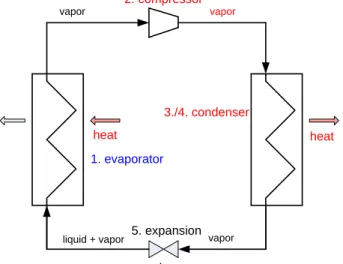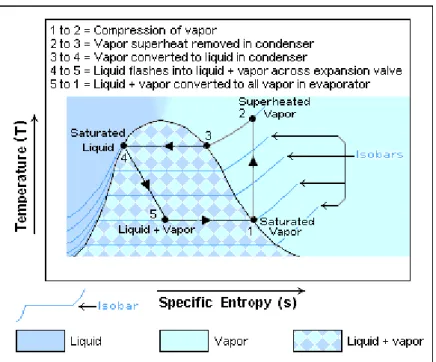Heat pumps
Kennisbank Bouwfysica
Auteur: dr. ir. Peter van den Engel
1 Introduction
A heat pump is a sustainable alternative for a boiler or a refrigerator (only being used as re-frigerator). The amount of use of primary energy can be substantially lower.
The principle of the heat pump is basically not different from a fridge, which was invented in 1805 by the American Oliver Evans. In 1834 Jacob Perkins got the first patent and build the first prototype, followed by John Gorrie in 1842 in order to cool hospital rooms and homes. The first commercial cooling machines were designed by Alexander Twining in 1856.
However, extensive use and more development of the performances of heat pumps have only been started since 1947, after the energy crisis in 1973 and again from 1990, mainly due to the rising energy prices. In many buildings heat pumps are operating nowadays. Heat pumps may be classified according to:
1. Type of heat source or sink.
2. Heating and cooling distribution fluid.
3. Type of thermodynamic cycle with following components: compressor, condenser, thermo-static expansion valve and evaporator.
The basic principles of a compression cooling machine or heat pump are illustrated by the following diagram of compression refrigeration. The numbers are shown as well in figure 2 and the process is described below figure 1.
heat
2. compressor
vapor vapor
1. evaporator
3./4. condenser
liquid + vapor 5. expansion vapor
valve
heat
Figure 1. Diagram of compression refrigeration
In a pipe-system a fluid is stored which can evaporate/boil and condensate at a chosen tem-perature. When the pressure rises by means of a compressor condensation of vapour (2) is easier to realize, when it is cooled down in a condenser (3). In a fridge the condenser can be seen at the backside. The gas has changed into a liquid by now (4). After this stage the liquid will pass an expansion valve (5) and the pressure drops after. This makes it possible for the liquid to change gradually into gas. When the fluid in the pipe passes the evaporator all the
cool warm air or liquid into cold air or cold liquid. After this stage the vapour goes back to the compressor.
In a cooling machine the heat from the condenser is not used and supplied to surrounding air or water. In case of a heat pump the heat from the condenser is used for heating purposes, like floor heating.
In the next T-S-diagram (T = K, S = kJ/kgK) the whole cycle is visualized:
Figure 2. T-S Diagram of compression refrigeration. The isobars are presented as well.
With a few simple equations the thermodynamically performance of a cooling ma-chine or heat pump can already be roughly evaluated. According to the first law of the thermodynamics the following equation is valid:
Qh = Ql + W W (1)
W = Qh – Ql W (2)
Where Qh is the highest and Ql the lowest energy-level and W is the amount of work The COP (coefficient of performance) is the amount of required energy (work) in order to produce a certain amount of energy (heat of cold):
W
Q
COP
=
- (3)This can be expressed in another shape in the following equation:
h heating
Q
Q
Q
COP
−
=
or l coolingQ
Q
Q
COP
−
=
- (4)The COP can be evaluated by the following equation: l h h heating
T
T
T
COP
−
=
- (5) l h l coolingT
T
T
COP
−
=
- (6)Equation 5 and 6 show that the smaller the system temperature differences are, the higher the COP will be. This is why high temperature cooling and/or low temperature heating will be most effective.
When the highest system temperature is 37oC = 310 K and the lowest system temperature is 7oC = 280 K the theoretical maximum COP will be 310 / (310 – 280) = 10.3. Generally efficien-cy losses are 50%, so in reality the COP for heating will be ca 5.
Moreover, a cooling machine or heat pump produces heat as well as cold, so the total COP in this example is almost twice as high. For instance, this is an option when aquifers are used in which heating and cooling energy can be stored or when there is a simultaneous heating and cooling demand like in a supermarket.
2 Types
Air to air heat pump.
It is suitable for factory-built unitary heat pumps. The air circuits for the evaporator and con-denser may be interchanged by dampers, to obtain either heated or cooled air for the condi-tioned space. The condicondi-tioned air will pass over the evaporator during the cooling cycle and the outdoor air will pass the condenser. During the heating cycle it is reversed. The changeo-ver may be accomplished in the refrigerant circuit (the heat exchangers are evaporator or condenser) or in the airflow. The evaporator is always the evaporator but the outside or the conditioned air is passing it during the cooling or heating cycle.
Water to air heat pump.
It uses water as a heat source and sink, and uses air to transmit heat to or from the condi-tioned space.
Water to water type.
For cooling as well as heating water is used. Energy can be extracted from an aquifer, the soil, waste water, seawater, a lake or river. The higher the temperature of the water in the heating season is, the higher the COP for heating will be.
Other types are possible. An example is an absorption heat pump, which utilizes solar energy as a heat source. However, the COP of this system is rather low: ca 0.7. The principles and options of this system will be discussed in another module. Absorption heat pumps are inter-esting as well when there is much “waste” heat available for instance during heat power gen-eration in summer.
heating and cooling. Generally gas driven heat pumps can produce higher temperatures due to the fact that the cogenerated heat from the motor can increase the temperature. In this way temperatures above 70oC are easy to reach in order to reduce legionella-riks.
Some general applications
By heat pumps in the heating mode of control 25 to 50% primary energy can be saved. The main product is heat and the by-product is cold. The value of the by-product depends on the simultaneous need of both products. In general seldom it coincides, but by thermal storage the use of the by-product can be improved. Cold and heat which is not useful at the actual mo-ments can be stored and used at proper momo-ments.
An interesting application for heating a block of houses is storing warm water in an aquifer in summer at 18-20°C. In winter it will be transported through non-insulated pipes to the block of houses. A heat pump per block uses it as a heat source and increases the water temperature of the heating system to 35°C or more. From there it will be transported through an insulated piping system to the various houses and used by a low temperature heating system (such as floor or wall heating). This heat source can be used as well by another heat pump in order to produce tap water of 65°C.
A general application of a heat pump in new built houses with natural air supply and mechani-cal exhaust is a heat pump that uses exhaust air as a source and produces warm tap water. Central or decentred heat pumps?
The distribution system of a central heat pump is one of the bottlenecks. Central hot water systems need relatively high temperatures in order to satisfy all users, especially when warm tap water is involved. Therefore, often an insulated double circulation system will be applied for domestic heating as well as warm tap water. Sometimes, the systems are combined such as district heating with a supply temperature of 73oC. The 73oC is reached by a combination of a heat pump and heat power generation.
A central low temperature heat source and individual heat pumps is an efficient solution relat-ed to energy consumption. However the maintenance of many small local heat pumps is more complicated and every house needs space for a heat pump.
Sizes of heat pumps
The size of a heat pump can be compared with the size of a cooling machine. The smallest heat pumps for domestic heating purposes need the following space: l x w x h = 1 x 1 x 2 m (heat pump itself = 0.6 x 0.6 x 1.80 m). This includes a storage tank for tap water.
Figure 3: Example of a heat pump that makes use of indoor exhaust air for warm tap water heating (Stiebel Eltron). Details: Height = ca. 1.80 m, storage of 300 l water included.
3 Conclusion
There is no general “best “ solution for the choice an integration of heat pumps, it depends on the type of project. Small temperature differences between heating and cooling are most fa-vourable.
4. Literature
1. Wisman WH, Meijer HC, Bart GCJ Inleiding thermodynamica. Delftse Universitaire Pers/VSSD. 1999.

